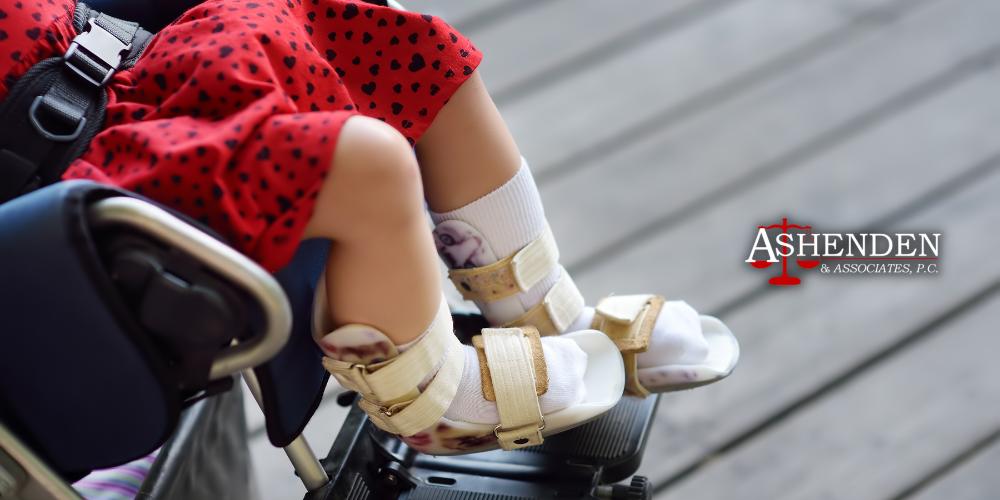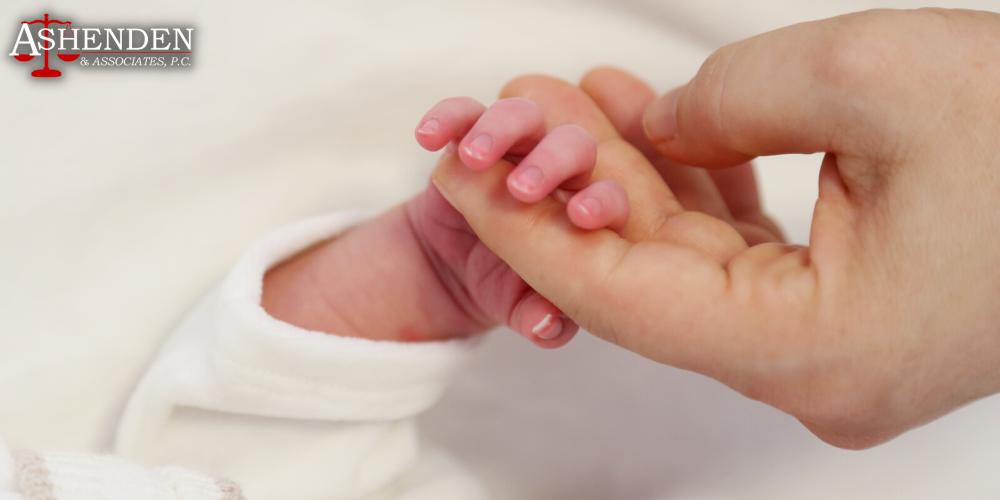The birth of a child is a miraculous occasion filled with anticipation and joy for parents. However, it can also be a time of intense anxiety because childbirth is risky for both mother and baby. Two significant complications that can arise during or after childbirth are birth injuries and birth defects. While both conditions can have serious consequences, they differ significantly in their causes and outcomes. Below, our Sandy Springs birth injury attorneys discuss birth injuries vs. birth defects, their similarities and differences, as well as whether new parents have grounds to take legal action.

At Ashenden & Associates, we are passionate about fighting for the justice of victims of serious birth injuries and birth defects that are the direct result of negligence. Our experienced attorneys have decades of combined experience in recovering millions of dollars in settlements for our injured clients. Call 770-394-8909 to schedule a free consultation at our law firm today.
What is a Birth Injury?
A birth injury, also known as birth trauma, is a physical injury sustained by a newborn during the birth process. These physical injuries often occur as a result of complications during labor and delivery or medical malpractice committed by healthcare providers. Birth injuries can range from minor injuries, such as scalp bruising and swelling, to severe injuries, such as brain injuries or spinal cord injuries. The most severe birth injuries can significantly alter a child’s life and cause them to suffer a wide range of developmental disabilities.
To learn more, contact our Sandy Springs brain injury attorneys.
How Common Are Birth Injuries in the United States?
According to the Centers for Disease Control and Prevention (CDC), approximately 7 out of every 1,000 babies delivered sustain birth injuries.

Common Types of Birth Injuries
The most common types of birth injuries include:
- Brachial Plexus Birth Palsy: This is one of the most common birth injuries and affects the nerves that control the arm and hand muscles. A brachial plexus injury often occurs when there is excessive pulling on the baby’s head and neck during delivery, leading to nerve damage. Erb’s palsy and Klumpke’s palsy are two specific types of brachial plexus injuries.
- Cerebral Palsy is a form of brain damage that causes permanent non-progressive motor conditions. In other words, damage to the fetal brain can cause the child to grow up and suffer with a variety of symptoms such as abnormal muscle movements, poor coordination, difficulty eating, delayed speech development, intellectual disabilities, and more. Premature babies may have a higher risk of suffering from Cerebral Palsy than babies who are born full-term. For more information, contact our Sandy Springs Cerebral Palsy attorneys.
- Cephalohematoma: Cephalohematoma is a collection of blood between the baby’s skull and the periosteum, a membrane that covers the bones. It can result from the use of forceps or vacuum extraction during delivery, which causes blood vessels to rupture. This condition may appear worse than it actually is. In fact, a cephalohematoma is typically considered a mild injury. Most newborn babies with this issue recover within a few weeks with no long-term deficits.
- Fractures: Bone fractures can happen during childbirth, most commonly in the collarbone or clavicle. These fractures often heal without complications but can be painful for the infant and distressing to new parents.
- Facial Nerve Injury: Pressure on the baby’s face during delivery can cause facial nerve injury, leading to facial paralysis on one side of the face.
- Intracranial Hemorrhage: In some cases, the baby may experience bleeding within the brain tissue, which can result from trauma during delivery. This is a serious condition that may require immediate medical attention.
Common Causes of Birth Injuries
The most common causes of birth injuries include:
- Prolonged or Difficult Labor: When labor is prolonged or difficult, it increases the risk of birth injuries as the baby may be subjected to prolonged pressure and stress during delivery.
- Instrumental Delivery: The use of forceps or vacuum extraction to assist in guiding the baby out of the birth canal can sometimes lead to injuries such as brain and spinal cord injuries. In fact, many doctors try to avoid the use of instruments during delivery due to the increased risk of injuring the baby.
- Large Baby Size: A baby who is larger than 8lbs, 13oz (macrosomia) may be at a higher risk of birth injuries because of the difficulty in passing through the birth canal.
- Breech Birth: Babies born in the breech position (feet or buttocks first) are at an increased risk of birth injuries compared to those born head first. Most doctors will resort to a C-section if babies are in the breech position and all attempts to turn them around have failed. However, some negligent doctors may move forward with vaginal birth regardless of positioning and attempt to guide the baby out of the birth canal feet-first, which can result in serious birth injuries.
- Maternal Health Conditions: Certain medical conditions that the mother has, such as gestational diabetes or preeclampsia, can increase the likelihood of birth injuries.
- Failure to Monitor the Mother’s or Baby’s Health: The labor and delivery process is often a whirlwind event for everyone involved, especially the doctors. One wrong misstep, such as not noticing fetal distress on the monitors and failing to take quick action, can mean the difference between life and death for the fetus. For example, fetal monitoring can reveal the nuchal cord, which is when the umbilical cord is wrapped around the baby’s neck, which leads to fetal distress and lack of oxygen. This is a very serious situation that requires immediate medical intervention.

What is a Birth Defect?
A birth defect, a congenital anomaly, or a congenital disorder is a structural or functional abnormality present at birth. Unlike birth injuries, which are often the result of external forces during labor and delivery, birth defects originate during prenatal development. Prenatal screening can help diagnose many types of congenital defects. Meanwhile, other birth defects aren’t noticed or diagnosed until the baby is born.
They can affect various body parts, including organs, limbs, and the central nervous system, and may lead to physical, intellectual, or developmental disabilities. Birth defects can range from mild to severe as the child continues to grow outside the womb. The severity of the defect usually depends on what organ or body part is affected.
How Common Are Birth Defects in the United States?
According to the Centers for Disease Control and Prevention, one in every 33 babies (3%) are born with a birth defect in the United States every year. Additionally, the leading cause of infant deaths is birth defects, accounting for about 20% of annual infant deaths.
Common Types of Birth Defects
Birth defects are highly diverse; there are thousands of known congenital anomalies. Some of the most common types of birth defects include:
- Heart Defects: Congenital heart defects are among the most prevalent birth defects, affecting the structure and function of the heart. Examples include atrial septal defects, ventricular septal defects, and Tetralogy of Fallot.
- Neural Tube Defects: These defects involve incomplete neural tube development, which forms the baby’s brain and spinal cord. Spina bifida and anencephaly are the most common examples of neural tube defects.
- Cleft Lip and Palate: Cleft lip and palate are facial malformations that occur when the tissue that forms the lip or palate does not fully come together during fetal development.
- Down Syndrome: Down syndrome is a chromosomal disorder characterized by intellectual disabilities and distinct physical features.
- Limb Deficiencies: Limb deficiencies can result in the absence or underdevelopment of limbs, such as missing fingers, toes, or limbs.
You may be wondering, how are these birth defects diagnosed? Most defects can be seen on regularly scheduled ultrasounds during a mother’s pregnancy. Other genetic conditions can be detected through blood tests during pregnancy or through newborn screening.
Common Causes of Birth Defects
Birth defects are very complex and can be caused by a combination of genetic and environmental factors. Most birth defects occur due to:
- Genetic Factors: Mutations or alterations in the baby’s genes can contribute to the development of birth defects. These genetic conditions may be inherited from the parents or occur spontaneously.
- Environmental Exposures: Exposure to certain teratogenic substances during pregnancy, such as alcohol, tobacco, certain dietary or herbal supplements, certain medications, and certain infections like rubella or Zika virus can increase the risk of birth defects. Additionally, exposure to harmful and carcinogenic chemicals through a contaminated water supply can lead to birth defects. In fact, birth defects were a very common, and tragic, consequence of the water contamination at Camp LeJeune military base between the mid-1950s to the mid-1980s.
- Maternal Health Factors: The mother’s health during pregnancy can influence the risk of birth defects. Maternal risk factors can include diabetes, obesity, and uncontrolled maternal phenylketonuria (PKU) can contribute to birth defects.
- Advanced Maternal Age: Older mothers are at a slightly higher risk of having a baby with certain birth defects.
Not all birth defects can be prevented, especially if the defect boils down to genetic factors. However, expecting mothers who take a prenatal vitamin (with folic acid) daily, attend all doctors appointments, manage their underlying medical conditions, don’t drink alcohol, and avoid dangerous environmental exposures usually go on to have healthy babies.

Birth Injuries vs. Birth Defects: What’s the Main Difference?
Birth injuries and birth defects are very similar in that they often result in permanent disabilities for the child. However, they also differ in many ways, such as timing, causes, preventability, prognosis, and long-term impact.
Timing
Birth injuries occur during labor and delivery, as a result of labor and delivery complications or medical malpractice.
Meanwhile, birth defects are present at birth. A birth defect often results from developmental abnormalities that occur during pregnancy. In many cases, doctors can identify a birth defect during prenatal diagnostic tests.
Causes
Birth injuries are primarily caused by mechanical forces, such as pressure, traction, or compression during childbirth.
On the other hand, the causes of birth defects are more complex and misunderstood, often involving genetic factors, environmental exposures, or maternal health conditions.
Preventability
Birth injuries are preventable with proper medical care, skilled obstetric practices, and timely interventions.
While some birth defects can be prevented through prenatal care and lifestyle choices, many are not preventable because they result from genetic factors.
Prognosis
The prognosis for birth injuries varies depending on the severity and type of injury. Many birth injuries can improve or resolve with medical treatment and therapy, such as speech therapy and/or occupational therapy.
The prognosis for birth defects also varies widely based on the type and severity of the defect. Some birth defects may require surgical correction or lifelong management.
Long-Term Impact
The long-term impact of birth injuries often depends on the extent of the injury and the effectiveness of treatment. Some children may experience lasting disabilities, while others who suffer minor injuries at birth can recover fully without long-term complications.
Birth defects can have a lifelong impact on a child’s health and development, and management may be required throughout their life. Some birth defects can even drastically shorten a child’s life-span.
Can You Sue for a Birth Injury or a Birth Defect?
Yes, you can sue for a birth injury if it was caused by medical negligence. For example, if a doctor used instruments to forcefully pull the baby out of the birth canal, and the baby suffered life-long brain damage as a result, then parents certainly have grounds to take legal action. Another common example of medical negligence during the birthing process is failing to pay attention to fetal distress monitors and not acting quickly enough. Babies in distress can easily suffer brain damage and even death, especially if their distress comes from a lack of oxygen or blood flow.
Now onto birth defects – in most cases, new parents cannot sue for their child’s birth defect unless it was directly caused by someone else’s negligence. For example, if it can be proven that the child’s birth defect was caused by exposure to harmful or carcinogenic substances – whether that be contaminated water, defective beauty products, or dangerous medications – then the parents of the child may have grounds to sue the negligent party. This is why many people are currently filing Camp LeJeune lawsuits – their children suffered life-altering or fatal birth defects.
The experienced legal team at Ashenden & Associates has the skill and experience necessary to handle both birth injury claims and Camp LeJeune birth defect claims. We can work closely with medical experts to determine who the negligent party is, and how negligence occurred.
Damages for Birth Injuries or Birth Defects
Sandy Springs birth injury lawyers at Ashenden & Associates can help new parents recover financial compensation for the following types of damages:
- Past and future medical expenses for the mother and child
- Past and future physical therapy for the child
- Lost wages for the parents
- Loss of earning capacity for the child, if their birth defect or injury causes long-term disability which will prevent them from working in the future
- Expenses for necessary medical equipment for the child, such as wheelchairs, leg braces, and other assistive equipment
- Full-time caregiver expenses
- Physical pain and suffering for both parents and child
- Emotional distress for both parents and child
- Mental health counseling expenses
- Loss of enjoyment of life
- Funeral and burial expenses if the birth injury or defect results in fetal death

Call Sandy Springs Birth Injury Lawyers at Ashenden & Associates Today
All new parents desire a healthy baby at birth and beyond, but tragically, this doesn’t always happen due to the negligence of medical professionals and other third parties. Our Sandy Springs birth injury lawyers understand the devastation surrounding infants born with lifelong disabilities and defects. That’s why we’re so passionate about fighting for the justice of these babies and their families.
If medical negligence directly caused your baby’s birth injury, it’s crucial to speak with an experienced attorney to figure out what your legal options are. Similarly, if your baby’s birth defect was caused by dangerous environmental exposure, defective products, or dangerous medications, it’s important to reach out to an attorney as well. You can trust that the Atlanta medical malpractice attorneys at Ashenden & Associates will fight for a fair settlement on behalf of your baby and your family. Call 770-394-8909 to schedule a free consultation at our law firm today.

